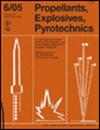Mesoscale modeling of the Shock‐to‐Detonation Transition of pressed‐HMX based on a surface regression model
IF 1.7
4区 工程技术
Q3 CHEMISTRY, APPLIED
引用次数: 0
Abstract
Shock‐to‐Detonation Transition (SDT) of heterogeneous high explosives results from processes occurring at the microstructural level. Thus, mesoscale modeling is expected to allow a better comprehension of the SDT. Recent experimental evidence suggested that hotspots mainly developed on the surface of the energetic crystals, which are then consumed by the propagation of a deflagration front. In the present study, mesoscale simulations of the SDT of pressed HMX were performed. The reactive model employed consisted of igniting the surface of the crystals after the shock passage, and reconstructing the burn front propagation, using a modified Youngs’ method. In this reactive model, the velocity of the deflagration front was modeled by a pressure‐dependent law, as suggested by the literature. The simulations showed that the Single Curve Initiation principle remained valid. The parameter deflagration velocity times the surface to volume ratio was found to enable the equivalence between microstructures. This approach provides a new framework to study the SDT of heterogeneous explosives, by considering how the combustion of energetic crystals participate to the shock acceleration and transition into a detonation. This paper serves as a proof of concept, applied to the pressed HMX.基于表面回归模型的压制-HMX 从冲击到爆炸转变的中尺度建模
异质高能炸药的冲击-引爆转变(SDT)是由微观结构层面的过程造成的。因此,中尺度建模有望更好地理解 SDT。最近的实验证据表明,热点主要出现在高能晶体表面,然后被爆燃前沿的传播所消耗。本研究对压制 HMX 的 SDT 进行了中尺度模拟。采用的反应模型包括在冲击通过后点燃晶体表面,并使用改进的杨氏方法重建燃烧前沿的传播。在这一反应模型中,爆燃前沿的速度是根据文献中的建议,通过与压力相关的定律来模拟的。模拟结果表明,单曲线起爆原理仍然有效。研究发现,爆燃速度乘以表面与体积比这一参数可以实现微结构之间的等效。通过考虑高能晶体的燃烧如何参与冲击加速和过渡到爆炸,这种方法为研究异质炸药的 SDT 提供了一个新的框架。本文是应用于压制 HMX 的概念验证。
本文章由计算机程序翻译,如有差异,请以英文原文为准。
求助全文
约1分钟内获得全文
求助全文
来源期刊

Propellants, Explosives, Pyrotechnics
工程技术-工程:化工
CiteScore
4.20
自引率
16.70%
发文量
235
审稿时长
2.7 months
期刊介绍:
Propellants, Explosives, Pyrotechnics (PEP) is an international, peer-reviewed journal containing Full Papers, Short Communications, critical Reviews, as well as details of forthcoming meetings and book reviews concerned with the research, development and production in relation to propellants, explosives, and pyrotechnics for all applications. Being the official journal of the International Pyrotechnics Society, PEP is a vital medium and the state-of-the-art forum for the exchange of science and technology in energetic materials. PEP is published 12 times a year.
PEP is devoted to advancing the science, technology and engineering elements in the storage and manipulation of chemical energy, specifically in propellants, explosives and pyrotechnics. Articles should provide scientific context, articulate impact, and be generally applicable to the energetic materials and wider scientific community. PEP is not a defense journal and does not feature the weaponization of materials and related systems or include information that would aid in the development or utilization of improvised explosive systems, e.g., synthesis routes to terrorist explosives.
 求助内容:
求助内容: 应助结果提醒方式:
应助结果提醒方式:


